Looking to be amazed by a crazy turtle? You’re in the right place! Here, we’ll cover everything you ever wanted to know about the strange mata mata turtle.
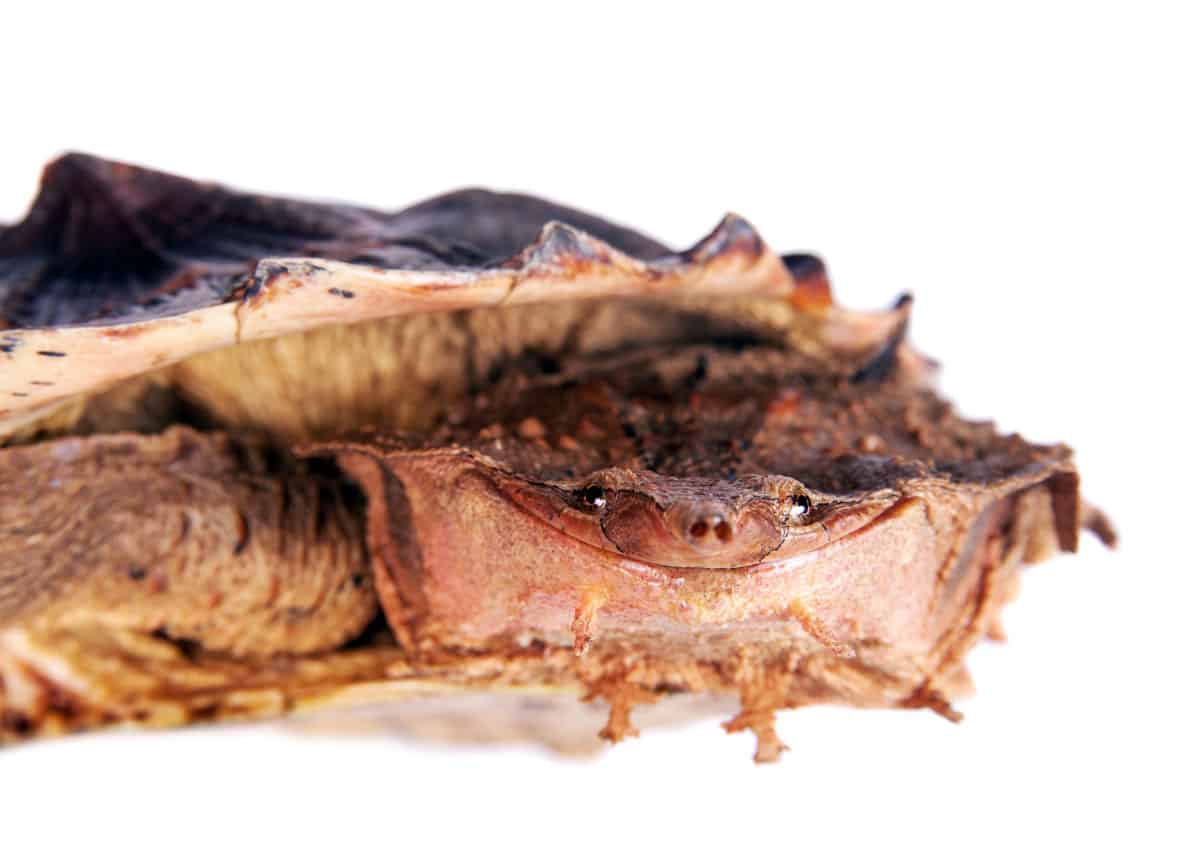
Table of Contents
39 Mata Mata Turtle Facts
If you’re looking at the mata mata turtle for the first time, you will probably be doing a double-take.
These curious creatures have one of the oddest appearances in the animal kingdom, and that’s not even getting into their unique feeding, nesting and camouflaging habits.
These definitely earn their spot on the weird animal list.
As with most things, however, there’s more to the mata mata turtle than what meets the eye. If you’re ready to dive into the realm of oddball animals, here are some fun mata mata turtle facts for you!
1. What is a mata mata turtle?
Mata mata turtles are aquatic turtles that live in the rivers and swamps of South America.
They’re a freshwater species, so you won’t find them on salty shores, but they’re spread out just about everywhere else. They’re also available for sale as exotic pets.
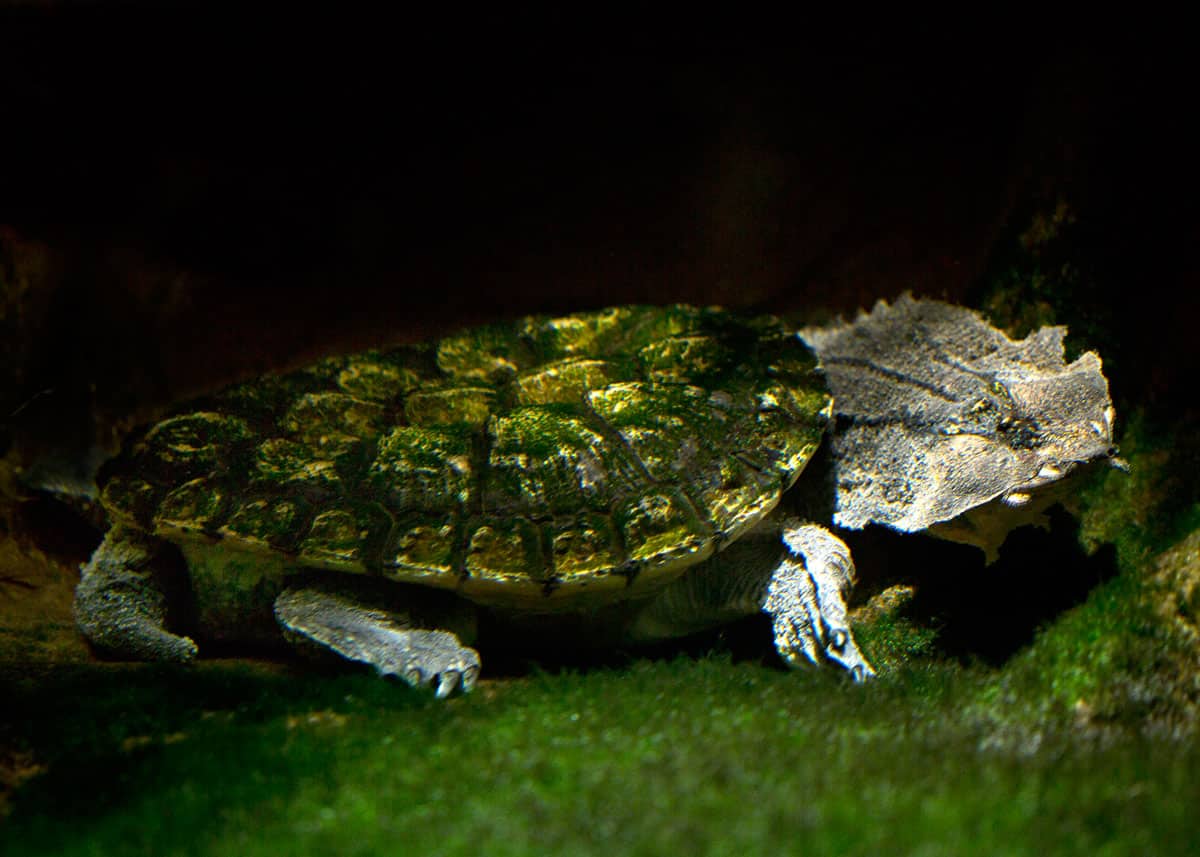
2. What other names does the mata mata turtle have?
You might see the mata mata turtle referred to as the “matamata,” “mata mata,” or “mata-mata.” They’re all equally valid spellings.
3. What is the mata mata turtles Latin name?
The scientific name of the mata mata turtle is Chelus fimbriata. It’s derived from the Latin words for “tortoise” (chelys) and “fringed” (fimbriatus).
4. How to say mata mata turtle? Pronunciation
“Mata mata” is pronounced with an “ah” sound like the one heard in “father.”
Some people mispronounce this, but you don’t have to be one of them!
5. Are there any other mata mata species?
Mata mata turtles are one of a kind.
In fact, they’re the only surviving turtle species of the entire chelus classification. The rest have gone extinct, so only the mata matas are carrying on the family name.
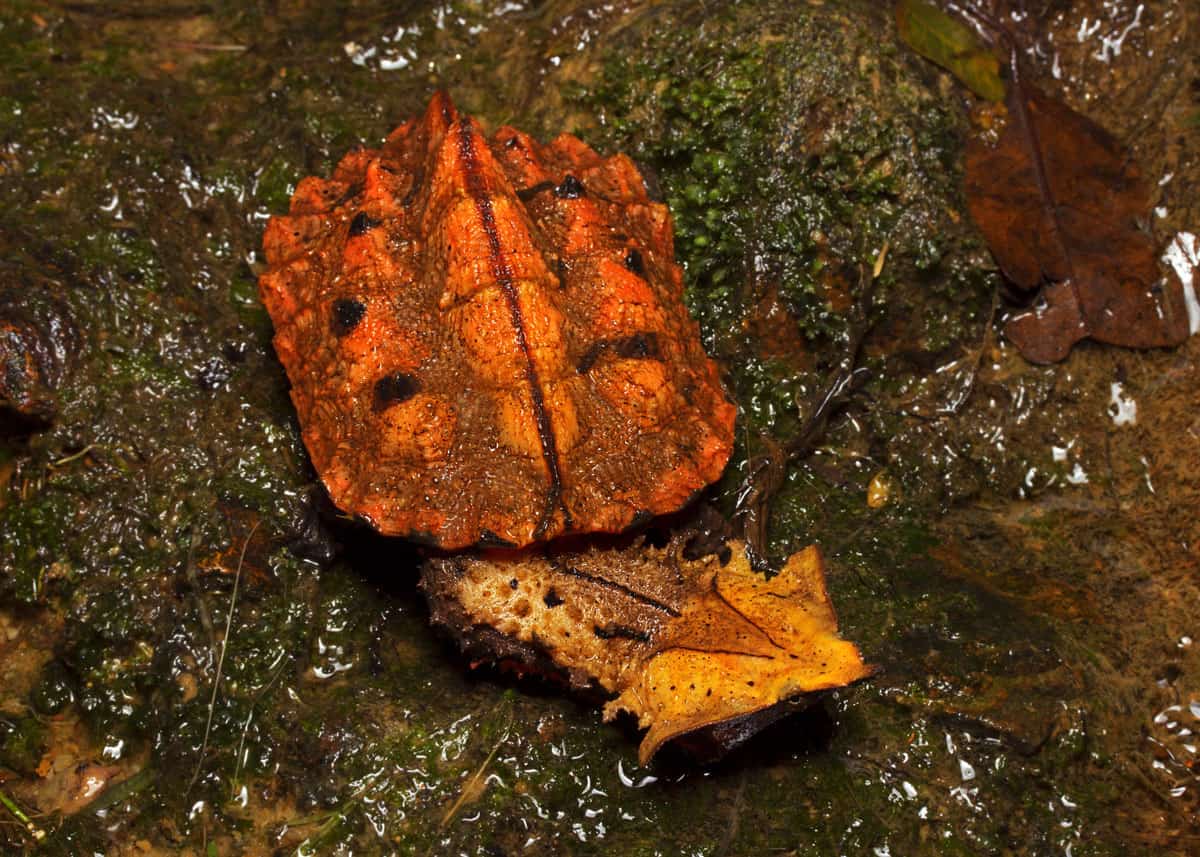
6. What does the mata mata turtle look like?
This is where things take a turn for the bizarre.
For starters, if you can even find the mata mata turtle, you’re doing better than most. They come in mottled shades of gray, brown, black and dark green that are meant to camouflage them as they hide in the water.
There’s also a lot of texture to their bodies. They have skin flaps and shell ridges; they have barbels and tubercles.
Combined with their neutral colors, this makes them look like leaves and tree bark floating in the river. It’s a unique disguise, but it works!
Another thing that you might notice about the mata mata turtle is their abnormally long neck that ends in a flat, triangular head with an upturned snout. These things are all adaptations to help them live in the water. I’ll explain more in a bit!
7. How big does a mata mata turtle get?
Mata mata turtles can grow up to 45 centimeters (18 inches) long. Most of this length is due to their neck.
8. How much does a mata mata turtle weigh?
They’re pretty hefty! Mata mata turtles can weigh up to 33 pounds.
However, most specimens are smaller, especially females. Females are almost always smaller than males.
9. How did the mata mata turtle get its name?
No one is quite sure where the mata mata turtle gets its name, but there are a few theories floating around:
- “Mata, mata” means “kill, kill” in Spanish, and since the turtles are native to South America, there might be a connection here.
- Another possibility is that mata mata turtles were misnamed after New Zealand’s Matamata. They’ve been traded around the world for centuries, and it isn’t uncommon for animals to get branded with the wrong point of origin when they’re imported and exported on a global scale. For example, Guinea pigs aren’t actually from Guinea.

10. Do mata mata turtles bite?
Mata mata turtles are capable of biting, but it’s rare.
They don’t feed that way, and they don’t have aggressive personalities that lead to biting instincts. Bites are usually nothing more than feeding accidents.
11. Are mata mata turtles freshwater or seawater turtles?
Mata mata turtles are freshwater turtles.
Experts say that they might be able to survive in salt water, but it hasn’t been observed or confirmed.
12. Are mata mata turtles good pets? 5 things to know
It depends on your definition of good!
Mata mata turtles are quite popular in the exotic pet trade, so you’ll have your choice of things like size, color, and gender.
You might have to pay a pretty penny to get the exact turtle that you want, but options will be available to you.
However, there are a few things that you should know about mata matas before opening your wallet:
- They don’t like to be handled. Mata mata turtles are happiest when you don’t interact with them at all. They won’t play with you like a puppy or even a snake and trying to force it can stress them out to the point of having health problems. They’re definitely a “display pet” rather than a “fun pet.”
- They can be picky about their environment. Mata mata turtles will need a wet, humid aquarium that mimics their native swamps and rainforests. Be prepared to fiddle around with things like heat, moisture and light exposure until you hit the right combination of elements.
- You’ll need to change their water a lot. Mata mata turtles are an aquatic species, so they’ll spend most of their time under the surface. However, it’s important not to let them languish in dirty water that collects bacteria and food debris. You’ll need to change it frequently, so don’t buy a mata mata if you lack the time for this regular chore.
- They can grow quite large. Baby mata mata turtles are tiny and cute, but two-inch hatchlings can mature into 18-inch adults. Make sure that you have space to accommodate their development.
- You can’t breed them. It’s extremely difficult to breed mata mata turtles in captivity, so put aside those visions of breeding your own exotic turtles for profit.
13. Do mata mata turtles bask in the sun?
No. While some turtle species like to bask in the sun as a form of thermoregulation, mata mata turtles don’t engage in this practice. They spend 99% of their time in the water.
Their favorite position is submerging themselves with only their snouts sticking out, and they can spend long hours completely motionless as they wait for their unsuspecting prey to cross their path.
14. Do mata mata turtles know how to swim?
Yes and no. They have the ability, but mata mata turtles are terrible swimmers.
They lack the speed and range of motion that’s needed to be truly comfortable as a swimming animal.

When they need to move, they’ll slowly walk across the muddy bottom of a shallow pond or stream until they reach their destination.
15. Are mata mata turtles friendly?
Mata mata turtles aren’t very cuddly. They aren’t hostile, but they’re natural loners that don’t even socialize with others of their kind unless it’s mating season.
If you’re thinking about buying the mata mata turtle as a pet, they’re definitely on the passive end of the engagement scale. Don’t expect a lot of interaction from them.
16. Are mata mata turtles aggressive?
No. They don’t hesitate when it comes to killing their prey, but mata mata turtles are very mellow creatures overall.
They aren’t territorial, and they don’t offer parental care to their young, so they don’t have any aggressive tendencies about nesting or feeding their babies. They mostly prefer to be left alone.
17. How long does the mata mata turtle live?
There’s a lot of conflicting information on the lifespan of mata mata turtles. This is probably because everyone is looking at different sample sizes; some specimens die early in the wild, but others can live twice as long in captivity.
18. Do people eat mata mata turtles?
They can be difficult to catch and consume, but there are some rural communities in South America that will eat mata mata turtles.
It isn’t an illegal or uncommon practice.
19. What eats a mata mata turtle? Predators and Threats
Mata mata turtles don’t really have predators. They escape a lot of notice thanks to their ninja-like maneuvering, and they have such thick skins and shells that they don’t make for easy targets.
It’s possible that their eggs are preyed upon by birds, rodents or snakes, but this hasn’t been widely observed enough to be definite.
20. Can mata mata turtles retreat into their shells?
Nope! It’s a myth that all turtles can hide underneath their shells.
Some of them are “side-necked turtles” that can only crane their necks sideways rather than completely withdrawing them. The mata mata turtle is a side-necked turtle.
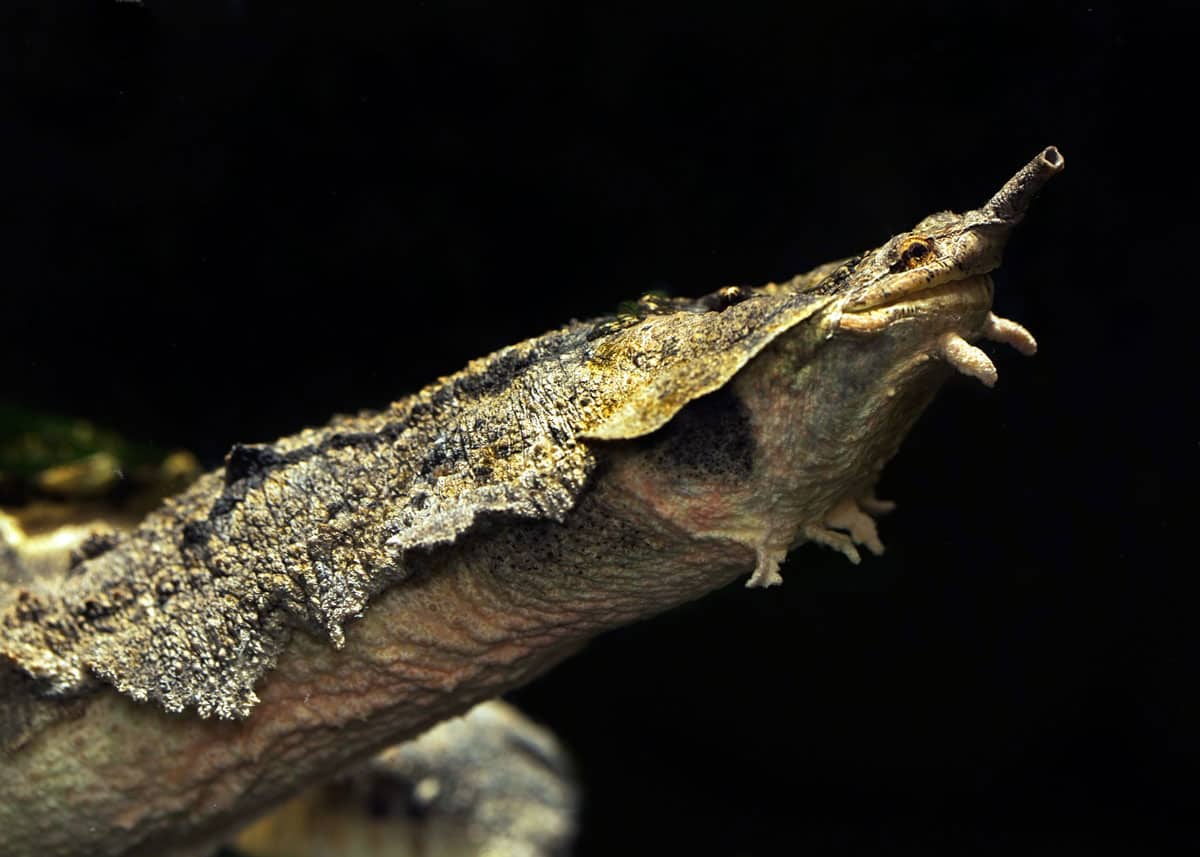
21. Is the mata mata turtle endangered?
The mata mata turtle hasn’t been evaluated by conservation groups, but it’s safe to assume that they’re doing just fine.
They have sizeable populations across a wide range of countries, and there’s no indication that their numbers are dropping beyond their ability to repopulate. It’s unlikely that they’re at any risk for extinction.
22. What threats face the mata mata turtle?
To completely counteract what I just said, there are a couple of things that have the potential to threaten the mata mata turtle in the future.
They aren’t pressing concerns just yet, but they’re something to consider:
- Deforestation is a major issue in the Amazon, and many animals have been forced to flee their native habitats as humans mine, log, build, dig and dam in their homelands. This is a particular concern for an aquatic turtle species like the mata mata. When the rivers are disrupted, their entire way of life is disrupted.
- Some mata mata turtles are illegally captured in the wild to be sold as pets. This is quite distressing for them, and even when they aren’t outright killed by the trauma, they can suffer health problems and behavioral issues once they’re in captivity. For example, young mata mata turtles have been known to stop eating after being excessively handled.
23. What does a mata mata turtle eat?
Mata mata turtles are carnivores that prey on fish and small invertebrates. In the wild, they like fish, frogs and insects.
In captivity, they can be fed minnows, mollies, goldfish, guppies and earthworms. Just make sure that their prey is alive! They aren’t interested in pre-killed food.
24. How does the mata mata turtle catch its meals?
When it comes to feeding, mata mata turtles present a strange contradiction.
On one hand, they’re slow-moving animals who use their natural camouflage to blend into their surroundings until their prey comes along.
They aren’t particularly fast or fierce, and their killing method isn’t gruesome. They just swallow live fish whole. It can be a strangely peaceful thing to watch a mata mata turtle drift along a school of fish and swallow them one by one.
On the other hand, when you learn the details of the mata mata’s execution style, it’s surprisingly brutal. They engage in something called “suction feeding” where they basically turn their mouths into vacuum cleaners.
It’s very fast. It’s also very efficient. The currents produced by the mata mata’s mouth are so strong that the fish would have no chance to escape even if they weren’t taken by surprise by the attack.
25. Can mata mata turtles chew their food?
No. Mata mata turtles are incapable of chewing because of the unique shape of their mouths and snouts.
This is why they prey on small animals; dinner has to be the right size to be swallowed in one motion.
26. Are mata mata turtles nocturnal?
This is a complicated question! They’re active during the day, so they aren’t considered completely nocturnal.
However, they do show a marked preference for hunting at night, and they have many adaptations that are suited for nighttime living.
27. What kinds of special senses do mata mata turtles have?
The mata mata turtle is in possession of something called the tapetum lucidum. Simply put, it’s a special lining in the backs of their eyes that gives them better night vision. Humans don’t have it, but owls, rodents, bats and crocodiles do.
Mata mata turtles also have a cool use for their long, semi-horned snouts. The snouts essentially function as snorkels so that the turtles can completely submerge themselves underwater with only their snouts peeking above the surface to take in oxygen.
28. Do mata mata turtles mate for life?
It isn’t known whether mata mata turtles mate for life.
However, they have complex mating rituals that suggest a certain kind of monogamy.
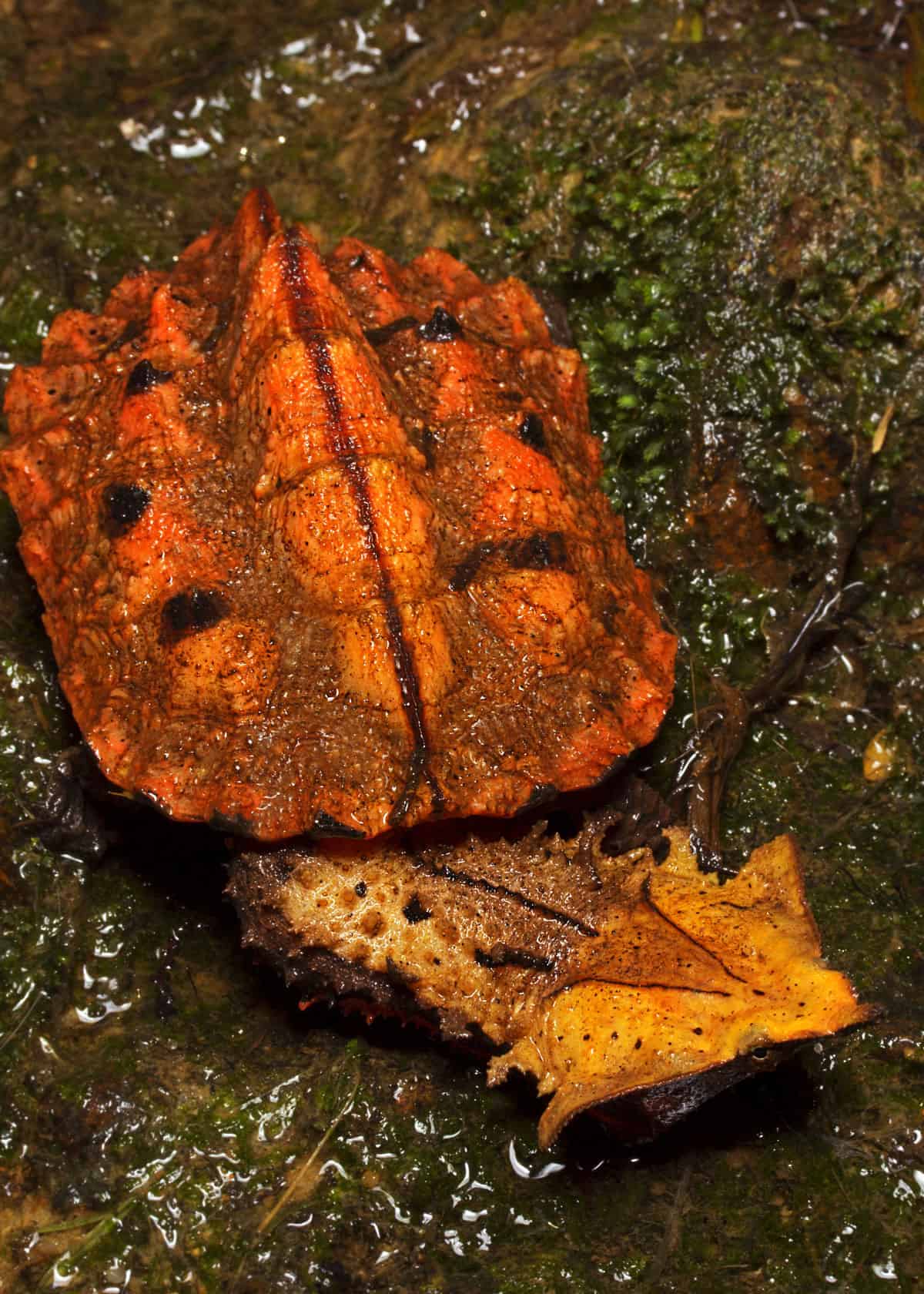
Males will extend their heads towards females while opening and closing their mouths, and they’ll flex their legs and move their skin flaps around as well.
The females have the choice of accepting or rejecting these proposals.
29. When is the mating season for mata mata turtles?
Mata mata turtles have a reproductive cycle that lasts from October to December. They only mate once per year.
30. Do mata mata turtles lay eggs?
Yes. Female mata mata turtles lay between 12 – 28 eggs at a time.
They’re usually round and brittle, and they measure 3 – 4 centimeters in diameter. They’re incubated in a clutch for about 200 days before they’re ready to hatch.
31. Where do mata mata turtles nest?
Most turtles in the Amazon like to incubate their eggs in open, sunny and sandy places.
The mata mata turtle has other ideas. Not only does it like to bury its eggs in a closed or excavated location, but it will even make a nest in decaying vegetation around swamps, marshes, and forests!
Incidentally, this is one of the few times that you’ll find the mata mata turtle emerging from the water.
32. Do mata mata turtles take care of their young?
You might think that mata mata turtles would carefully tend to their babies after incubating them for the better part of a year, but this isn’t the case.
Mom and dad offer very little parental care once their eggs are hatched. The babies come into the world, mature quickly and fend for themselves.
33. What are young mata mata turtles like?
In a surprising twist, mata mata turtles are colorful little critters that only lose their pigmentation as they get older.
When they’re juveniles, they have pinkish-red bodies with black and green mottling, and the pink slowly fades into yellow, orange, brown and gray.
When they reach maturity, they’ll have their famous neutral tones.
Young mata matas are also known to be more flexible than their parents. They can swim better, and they’re more active as they move in and through the water. They slow down as they age and lose their mobility.
34. Do mata mata turtles carry disease?
Mata mata turtles can carry parasites, especially when they’re being kept as pets and fed with live bait.
However, there’s no indication that these parasites carry any risk to humans. They’ll only affect the health of the mata mata turtle that hosts them.
35. Why do mata mata turtles have so many skin flaps?
While the skin flaps of the mata mata turtle can help them look like dead leaves in the water, camouflage isn’t the only reason for their existence.
Scientists have discovered that mata mata turtles have all kinds of nerves located in their skin flaps; they just aren’t sure what the nerves actually do.
Their best guess is that the flaps are used to detect sounds and vibrations in the water. As I’ve already discussed, mata mata turtles have a lot of features that help them thrive in the water.
36. Are mata mata turtles from Matamata?
No. Matamata is a real place in New Zealand, where they filmed The Lord of the Rings.
But mata mata turtles don’t have anything to do with wizards and hobbits. They’re located on the other side of the globe.
37. Where do mata mata turtles live?
Mata mata turtles are native to South America.
They stretch over a large portion of the continent, including Brazil, Bolivia, Colombia, Peru, Ecuador, Venezuela, and the Guianas. They can also be found on the island of Trinidad.
38. What is the habitat of the mata mata turtle?
Mata mata turtles spend most of their days in the water; they’ll only venture on land when hunting or nesting demands it.
They like slow-moving rivers and streams as well as stagnant pools and swamps.
39. Where can I see the mata mata turtle?
Good news! Mata mata turtles aren’t rare or endangered, so if you want to see these strange creatures for yourself, it’s just a matter of finding a zoo or wildlife exhibit that’s showcasing them.
You can also check out exotic pet stores if you’re thinking about buying a mata mata turtle of your very own.
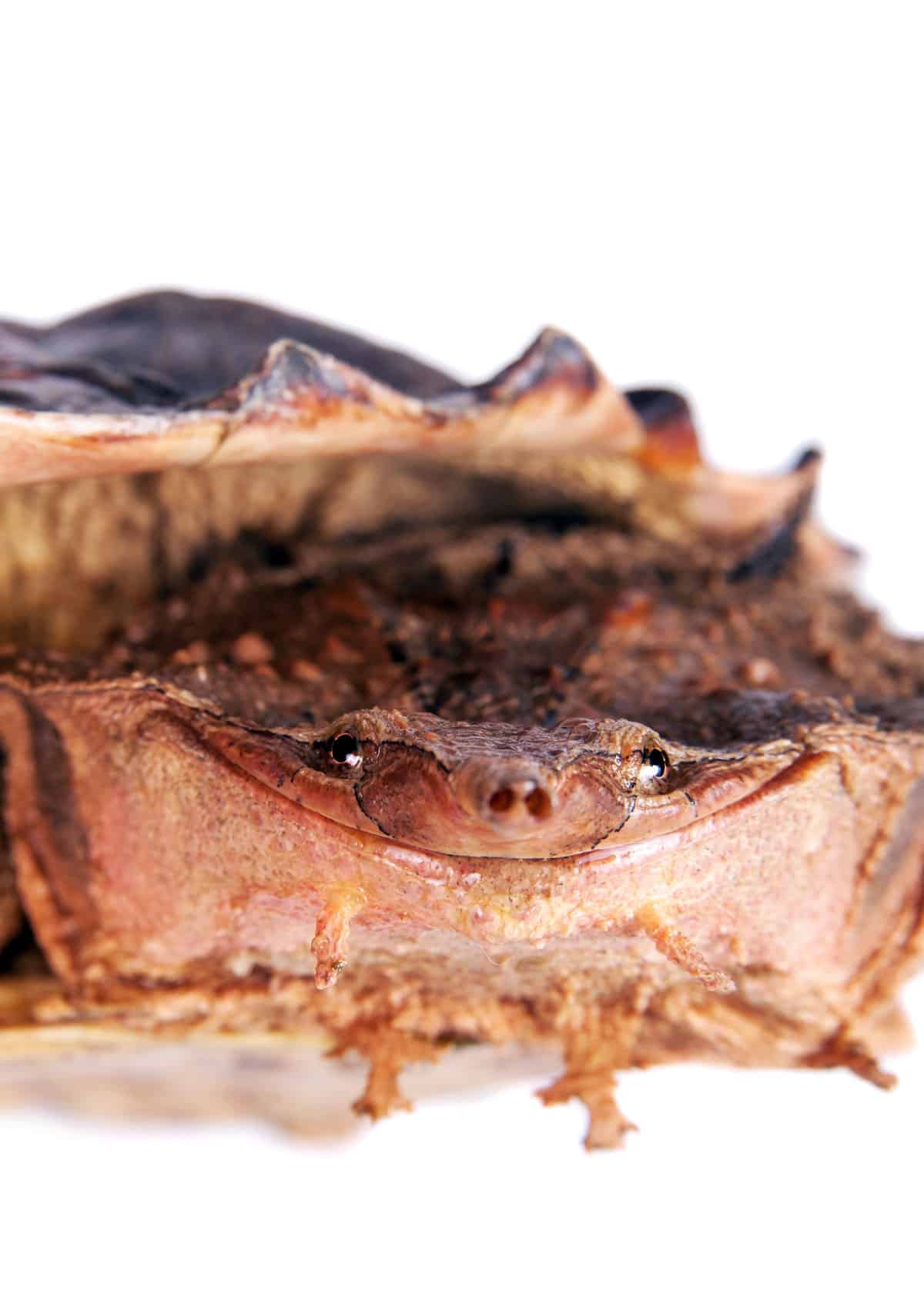
That’s a winning grin!
What’s In A Name?
They’re the last of their kind. They have shells, horns, skin flaps and vacuum suckers for mouths. They don’t actually come from Matamata. There’s certainly a lot to boggle at when it comes to mata mata turtle facts, but hopefully, they were fun to read!
Drew Haines is an animal enthusiast and travel writer. She loves to share her passion through her writing.
She graduated high school at sixteen and started her own business, Everywhere Wild Media. And she runs Everywhere Wild and JustBirding. She also guest blogs on Storyteller.Travel
She lived in Ecuador for 6 years and explored the Galapagos Islands. Currently based in N.S., Canada.
